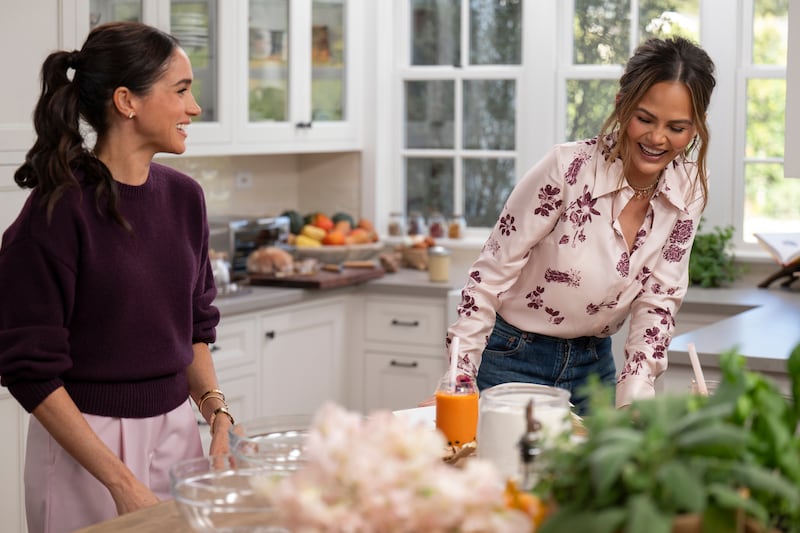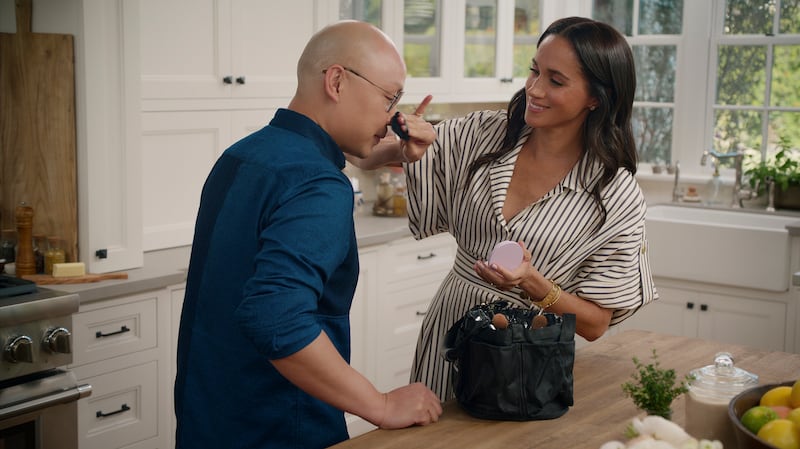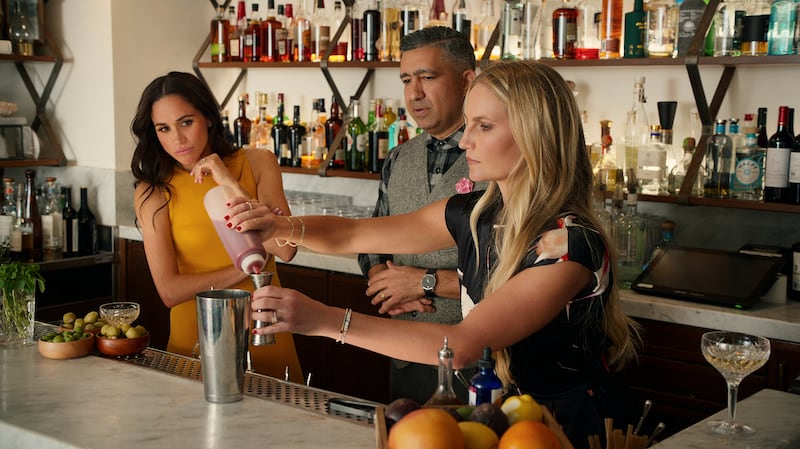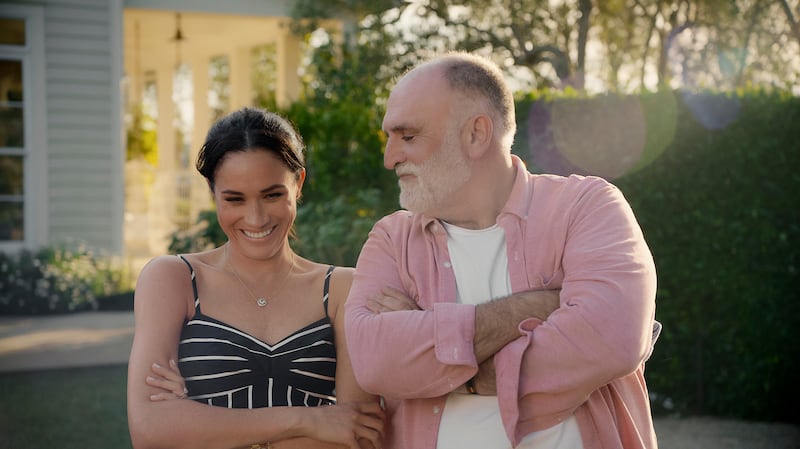If you liked the debut season of With Love, Meghan, you’ll love the second. If you hated the first, you’ll find plenty to loathe in the sequel.
That’s because the so-called second series, dropping on Netflix on Tuesday, is not a new creation at all, but a continuation of footage shot alongside the original batch.
Rather than a genuine recommission, it’s simply more hours from the same shoot, repackaged with a fresh set of credits.

The concept remains the same: you are meant to believe you’re inside Meghan Markle’s home, sharing in her cooking and hosting rituals, when in reality you’re inside a borrowed set made to look lived-in. The cameras linger on house exteriors, manicured gardens, even a sequence of Meghan packing for a trip upstairs, while production notes and the first series freely acknowledge that the location is not her actual and residence. The result is a strange disconnect, and it gnaws away at the core problem with the show: authenticity.
Back again in a supporting role is Meghan’s longtime friend and makeup artist Daniel Martin, who, in the odd calculus of With Love, Meghan, has been installed as her permanent sous-chef and confidant. Martin is a pleasant fellow, but his sole function seems to be to affirm everything Meghan says—“that’s a good plan,” “that’s awesome”—with the glazed enthusiasm of someone who admits they are more used to refrigerating cosmetics than food.

Unlike breakout stars such as Kaleb Cooper from Clarkson’s Farm, who stumbled into television fame by force of personality, Martin comes across as a plant aiming to replicate the trick. Sadly, his presence doesn’t lift the series; it only underlines how little spontaneity there is in the whole enterprise.
The episodes themselves veer between the banal and the baffling. In one, the group gathers to cook dinner, but the editing is so chaotic—pots moving, dishes half-formed, food dropped on the floor—that it becomes impossible to follow what anyone is making.
Everyone keeps mumbling about getting out of their comfort zone. By the time they are toasting artisanal s’mores on a bonfire, any sense of culinary purpose has entirely evaporated.

Meghan herself admits, with a strangely revealing flourish, that she doesn’t enjoy baking because it is “too directional.”
She proposes to “rethink baking to be more spontaneous,” as though the ancient custom of mixing flour, sugar, and eggs were a lifestyle brand in need of disruption. The result is as awkward as it sounds. Nobody looks glamorous biting into a molten marshmallow; no amount of soft-focus camera work can disguise the mess.
Episode four introduces Tan France, the host of Netflix’s Queer Eye, but instead of chemistry, there is contrivance.
Meghan opens the episode by spending, I would estimate, $200 on hardback children’s books for her “new friend,” wraps them with care, and prepares an elaborate fruit platter with yogurt and lattes to greet him.
The gesture plays, not as generous but as staged, especially when, upon arrival, the “friends” greet each other with mutual “so nice to meet yous.”
The supposed theme of friendship and hosting collapses under the weight of that moment: two people who have never met are asked to play lifelong confidants for the sake of 40 minutes of television. It is, at best, a curious way to manufacture intimacy; at worst, a failure of the show’s premise.

The best of the eight episodes is the finale with chef José Andrés of World Central Kitchen. Andrés brings genuine warmth, interacting with the crew, handing out slices of cheese, and making the show feel, briefly, like a shared table rather than a staged tableau.
Meghan herself is more animated with him than at any other point. But the spell breaks when the camera suddenly shifts from sun-dappled collegiality with Andrés to a scene of Meghan observing the gutting of sea urchins on a dockside, scooping out their innards in a scene more suited to a food documentary than to this pastel-tinged fantasy.
The juxtaposition is jarring: one moment bees and blossoms, the next sea urchin viscera. The tonal whiplash makes it hard to know what kind of show With Love, Meghan even wants to be.
The numbers tell their own story. When With Love, Meghan launched in June, it managed 12.6 million hours viewed in its first week and briefly entered Netflix’s global top 10. But by July, it had slumped to 383rd among all shows on the platform, with 5.3 million total views. Many YouTubers playing video games clock that many eyeballs in a 24-hour binge.
The score technically put the show in the top 10 percent of Netflix content, but only by the generous math of a platform that releases hundreds of titles a year and screens thousands more repeats. More tellingly, Meghan and Prince Harry’s once-heralded $100 million Netflix deal has now been rewritten into a much smaller “first-look” arrangement, a clear sign that the collaboration has underperformed.
A holiday special is planned later this year; presumably, it will also be drawn from the same bank of pre-recorded episodes.
The larger picture is clear: the experiment in turning Meghan into the natural heir to Martha Stewart or Gwyneth Paltrow as a lifestyle guru has not taken root.
The camera cannot manufacture warmth, nor can it disguise the gap between the Meghan on screen and the off-screen reality. What began as a glittering showcase has ended up as just another tranche of Netflix filler.
The truth is inescapable; Meghan pulled off a coup, getting With Love, Meghan commissioned once. That it returned in this cut-and-paste format is down to the economics of momentum. But a third run? That seems unimaginable.
The attempt to crown Meghan as television’s new homemaking star has failed.
Want more royal gossip, scoops and scandal? Head over to The Royalist on Substack
The post Meghan Markle’s Show Returns For Another Season Of Carefully Curated Inauthenticity appeared first on The Daily Beast.




